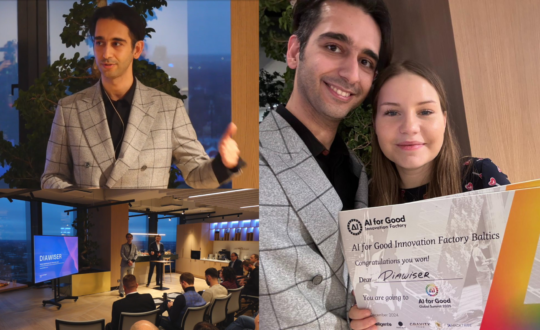At least half of the world’s population cannot obtain essential health services.
But low-cost, easy-to-use technologies powered by Artificial Intelligence (AI) promise to deliver quality and affordable health care to the people who need it most, no matter how hard to reach.
At the AI for Good Global Summit last week, entrepreneurs, AI experts, academics and UN representatives described many AI technologies for health, allowing for the early detection of various pathologies such as osteoarthritis, diabetic retinopathy, child malnutrition, snakebites and others. These technologies don’t place a heavy burden on doctors, and can lead to prompt diagnosis and effective treatment.
They agreed that AI can add tremendous value in developing countries where there is a low density of physicians.
“The technology on its own is not going to give us the magic bullet we are seeking to achieve Universal Health Coverage by 2030…This requires ecosystems innovation, innovations in ethical spaces and on legislative issues, new financing models, and new business models.” –Stefan Germann
But a fundamental question emerged from the audience: how can we help move these promising solutions beyond the pilot stage, so they are widely adopted and integrated into broader health systems?
RELATED: Health For All: using ICTs to reach the last mile
The participants agreed that the wide adoption and scale-up of innovative, AI-powered technologies for health requires the following 4 actions:
1. Create effective systems and tools for innovation
Effective ecosystems for innovation and collaboration are needed to scale up AI-powered technologies for health.
“The technology on its own is not going to give us the magic bullet we are seeking to achieve Universal Health Coverage by 2030,” explained Stefan Germann of the Botnar Foundation. “This requires ecosystems innovation, innovations in ethical spaces and on legislative issues, new financing models, and new business models”.
As a first step towards creating a mechanism for wide collaboration, participants proposed to create an ITU Focus Group on health and AI to promote coordination, reduce duplication, and work jointly towards concrete deliverables and the operationalization of the various projects proposed at the Summit.
It was suggested that the Focus Group can help to bring ideas to implementation and scaled-up deployment through the consideration of use-case descriptions, common interfaces and architecture, service and business models, country deployment mechanisms, ways to evaluate impact, and some degree of certification that these AI devices for health actually work, which in turn may require data and regularization standards.
2. Build big partnerships for Big Data
Collaboration is essential for innovation, and also to bring Big Data solutions to scale.
Jeanine Vos, Head of SDG Accelerator at the mobile industry trade group, GSMA, explained how “mobile Big Data” can help to solve some of the world’s complex challenges.
RELATED: Big data for social good: How Telenor is using big data to tackle big problems
She provided an overview of GSMA’s initiative for Big Data for social good launched last year. GSMA’s 5 billion mobile industry customers generate data that indicate their location and movement across the network. GSMA aggregates and anonymises this data to provide powerful insights into how mobile Big Data can help governments and agencies to better understand, predict, plan, and respond to emergencies, while still protecting and respecting customers’ privacy.
“When we talk about Big Data, the elephant in the room is that many people are not covered by Big Data. The most vulnerable probably do not have a phone.” — Clara Palau Montava
In Brazil, for example, 20,000 people died last year because of air pollution.
Ms Vos explained that Telefonica used machine learning to predict death 24 hours in advance, leveraging mobile big data and layering it with weather and traffic information. They established a model to help policy makers, municipalities, and governments to take action before air pollution hotpsots strike, by closing certain routes for populations at risk for example, or redirecting traffic.
RELATED: How AI and Big Data are tackling the health impacts of urbanisation
But the accuracy and relevance of AI’s predictions depends on the quality, legibility and completeness of the data it relies on.
Clara Palau Montava, Technology Team Lead at UNICEF said: “When we talk about Big Data the elephant in the room is that many people are not covered by Big Data. The most vulnerable probably do not have a phone”.
Since the 2014 Ebola crisis in West Africa, UNICEF has been using mobile phones and mobile phone data, combined with human mobility patterns, and meteorological and entomological information, to help fight the spread of epidemics. UNICEF is now looking at how AI can help infer data and models for invisible populations.
She explained,“if you train an algorithm with data that is not representative data, then the outcome will not be representative either…. This is not a problem only one organization can address. We believe in open source software and open collaboration”.
Since high-quality, labeled datasets are essential for AI algorithms, some AI solutions rely on the power of the crowd for data curation. One proposal called Crowdbreaks, developed by the Digital Epidemiology Lab at EPFL in Switzerland is an open platform which allows tracking of health trends by making use of continuous crowd-sourced labeling of public social media content.
3. Bring transparency into the ‘black box’ of AI
According to Shinjini Kundu, Research Fellow at the University of Pittsburgh Medical Center, providing transparency is critical to scale up AI solutions in health care.
“AI needs to be able to explain its reasoning,” says Dr Kundu. “So for example, if you have an AI system that assesses your risk of a type of cancer, and if it says your risk is high and that is a false positive and that patient undergoes an expensive biopsy, there are costs both in terms of patient suffering and monetary costs. The stakes are very high.”
“If the AI system is doing something incongruous with conventional thinking, it could be wrong or it could be teaching us something. We really need to know which”-Shinjini Kundu
Dr Kundu explained that this consideration motivated her research in medical image processing. Her ‘Transport Based Morphometry Technique’ or TBM allows for insight into AI reasoning in the processing of medical images.
Dr Kundu’s research focuses on osteoarthritis detection, where scans of human knee cartilage contain information that enables the prediction of those who will develop osteoarthritis 3 years down the line with up to 86% accuracy.
“It’s puzzling, because our eyes cannot pick out common pattern that separates these groups” she said.
However, TBM shows that what it uses to classify its predictions is the presence of water indicating weakening in the cartilage among those who will go on to develop osteoarthritis.
Ms Kundu explained: “TBM allows us to look into the black box, and this is the most exciting part of our work.”
She continued: “The key challenge for technology is, how do you make it transparent both for doctors and patients to be able to understand what the AI system is using? If the AI system is saying something unreasonable, the doctors need to be able to override what it is doing. Also, if the AI system is doing something incongruous with conventional thinking, it could be wrong or it could be teaching us something. We really need to know which.”
4. Ensure security and privacy
Throughout the Summit, participants consistently reiterated the need to aggregate and anonymise data and to protect and respect users’ privacy.
Adam Perold, Co-founder, and CEO at Element has developed mobile software for biometric identity. His solution is a portable, pure software mobile platform, which focuses on inclusion, safety and privacy.
Describing his solution’s safety feature, he said: “If the attacker gets through, what they get is useless. We built a platform with fragmentation so that identities sitting across the cloud are not sufficient to match the person, and cannot be used to reconstruct their features”.
The solution is at a mature stage and is already deployed at a large scale across many countries.
Capturing the spirit of the conversations at the summit, he said: “The point is not the biometric systems, although that is what we do. The point is connecting people to health systems and banking and the telecoms systems, to empower them”.
He added: “The SDGs seem ambitious but the opportunity of these new tools can change the way we think about these goals.”














